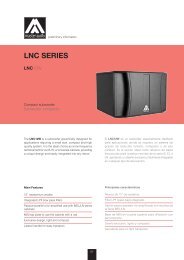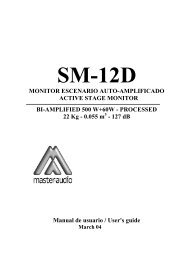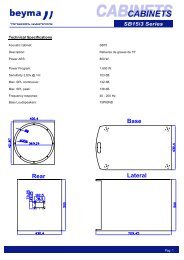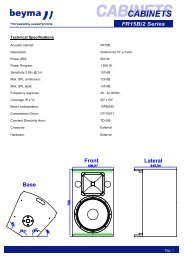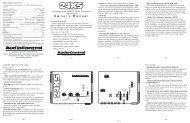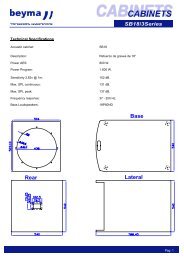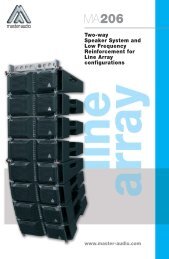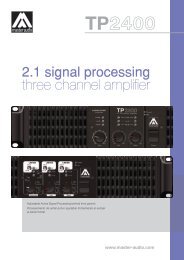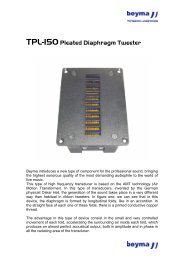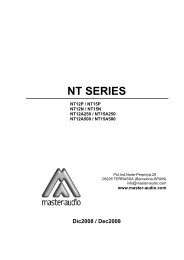PRO SERIES
PRO SERIES
PRO SERIES
You also want an ePaper? Increase the reach of your titles
YUMPU automatically turns print PDFs into web optimized ePapers that Google loves.
<strong>PRO</strong> <strong>SERIES</strong><br />
P26A / P10A<br />
P12A / P15A<br />
P212A<br />
P318A<br />
P15SWA<br />
P18SWA<br />
P12SMA / P15SMA<br />
AMATE ELECTROACÚSTICA,S.L<br />
Pol.Ind.Norte-Perpinyà,25<br />
08226 TERRASSA (Barcelona-SPAIN)<br />
info@master-audio.com<br />
www. master-audio.com<br />
Manual de usuario / User's guide<br />
Septiembre 07 / September 07
ESPAÑOL<br />
CAUTION<br />
RISK OF ELECTRIC SHOCK<br />
DON’T OPEN<br />
Instrucciones de seguridad<br />
1. Todas las instrucciones de seguridad deben<br />
ser leídas antes de utilizar este aparato.<br />
2. El signo de exclamación dentro de un<br />
triángulo indica componentes internos cuyo<br />
reemplazo puede afectar la seguridad.<br />
3. El símbolo del rayo con la punta de la flecha<br />
indica la presencia de voltajes peligrosos no<br />
aislados.<br />
4. Este equipo no debe ser expuesto a la lluvia<br />
ni a la humedad. No lo use, por ejemplo, cerca<br />
de piscinas, fuentes o cualquier lugar donde<br />
pueda ser afectado por líquidos.<br />
5. Limpie el aparato sólo con paños secos.<br />
6. No sitúe el equipo en lugares donde se<br />
interfiera la ventilación del aparato.<br />
7. No instale el aparato cerca de ninguna fuente<br />
de calor, como radiadores, estufas u otros<br />
aparatos que emitan calor.<br />
8. Este equipo debe ser reparado por personal<br />
cualificado del servicio técnico cuando:<br />
A. El cable de red esté dañado, o<br />
B. Algún objeto o liquido haya dañado el<br />
aparato; o<br />
C. El equipo no funcione de una manera<br />
normal (correcta); o<br />
D. El equipo se haya expuesto a la lluvia; o<br />
E. El chasis esté dañado<br />
9. Desconecte el aparato en caso de tormentas<br />
eléctricas o cuando no vaya a emplearlo<br />
durante largos períodos de tiempo.<br />
10. No cuelgue el equipo por el asa.<br />
Safety Instructions<br />
ENGLISH<br />
WARNING:<br />
To reduce the risk of fire or electric shock do<br />
not expose this equipment to rain or moisture<br />
1. All the safety and operation instructions<br />
should be read before this product is operated.<br />
2. The exclamation point within an equilateral<br />
triangle is intended to alert the user of the<br />
presence of internal components whose<br />
substitution may affect safety.<br />
3. The lightning flash with arrowhead symbol<br />
within an equilateral triangle is intended to<br />
alert the user of the presence of uninsulated<br />
dangerous voltage that may constitute a risk of<br />
electric shock to persons.<br />
4. This product should not be exposed to rain<br />
or moisture. Do not use it, for example, near a<br />
swimming pool, water fountain or any liquid<br />
sources.<br />
5. Clean only with a dry cloth.<br />
6. This product should be situated so that its<br />
location does not interfere with its proper<br />
ventilation.<br />
7. Do not install near heat sources such as<br />
radiators or other devices which produce heat.<br />
8. This equipment should be serviced only by<br />
qualified service personnel when:<br />
A. The power-supply cord or the plug has<br />
been damaged; or<br />
B. Objects have fallen, or liquid has spilled;<br />
or<br />
C. This product does not appear to operate<br />
normally; or<br />
D. This product has been exposed to rain; or<br />
E. The chassis is damaged.<br />
9. Unplug this product during lightning storms<br />
or when unused for long periods of time.<br />
10. Do not suspend the cabinet from the handle
Amate Electroacústica,s.l.<br />
1.INTRODUCCIÓN<br />
1.1. Generalidades<br />
Amate Electroacústica, s.l. le agradece la<br />
confianza depositada en nuestros productos de<br />
la Serie <strong>PRO</strong>.<br />
La experiencia de más de 30 años en el diseño<br />
de cajas acústicas y amplificadores y la<br />
utilización de la más alta tecnología y<br />
componentes convergen en un producto<br />
idóneo para multitud de aplicaciones, tanto en<br />
instalaciones fijas como sonorización en<br />
directo. ¡La nueva Serie <strong>PRO</strong> sorprenderá por<br />
su ligereza, calidad, potencia y fiabilidad.<br />
Le sugerimos lea atentamente las indicaciones<br />
que a continuación exponemos, confiando en<br />
que le serán de gran utilidad.<br />
1.2. Características y presentación<br />
P-26A<br />
- Entrada balanceada electrónicamente (XLR).<br />
- Salida paralela con conector XLR.<br />
- Entrada de Red PowerCon.<br />
- Salida AC Stacking Output con PowerCon.<br />
- Divisor Activo de 24 dB/Oct.<br />
- Amplificador Clase D de 200 W.<br />
- Altavoces de 6" con cono de Kevlar.<br />
- Amplificador de Clase AB de 30 W.<br />
- Tweeter con diafragma de Titanio de 1".<br />
- Total procesamiento de señal con limitadores<br />
de clipping.<br />
P-10A<br />
- Entrada balanceada electrónicamente (XLR).<br />
- Salida paralela con conector XLR.<br />
- Entrada de Red PowerCon.<br />
- Salida AC Stacking Output con PowerCon.<br />
- Divisor Activo de 24 dB/Oct.<br />
- Amplificador Clase D de alto rendimiento de<br />
500 W.<br />
- Altavoz de 10" de Neodimio y alto<br />
rendimiento.<br />
- Amplificador de Clase AB de 60 W.<br />
- Motor de agudos de Neodimio.<br />
- Total procesamiento de señal con limitadores<br />
de clipping.<br />
1. INTRODUCTION<br />
1.1. General<br />
Amate Electroacústica, s.l. would like to<br />
thank you for your confidence in our <strong>PRO</strong><br />
Series.<br />
A gathered experience of more than 30 years in<br />
the design of acoustic cabinets and amplifiers,<br />
together with the application of the most<br />
advanced analysis devices have allowed the<br />
<strong>PRO</strong> Series become the optimal and ideal<br />
solution for fixed installations and especially<br />
for live events. Its lightweight, quality,<br />
power, and reliability will not fail to surprise!<br />
We suggest you to carefully read the following<br />
instructions in order to obtain the best results in<br />
performance.<br />
1.2. Features and presentation<br />
P-26A<br />
- Electronically balanced Input (XLR).<br />
- XLR parallel output.<br />
- AC PowerCon Input.<br />
- AC Stacking Output with PowerCon.<br />
- 24dB/Oct Active Crossover.<br />
- 200 W Class D Amplifier.<br />
- 6" Woofers (with Kevlar cone).<br />
- 30 W Class AB Amplifier.<br />
- 1" Titanium dome tweeter.<br />
- Full Signal Processing with active clip<br />
limiters.<br />
P-10A<br />
- Electronically balanced Input (XLR).<br />
- XLR parallel output.<br />
- AC PowerCon Input.<br />
- AC Stacking Output with PowerCon.<br />
- 24dB/Oct Active Crossover.<br />
- 500 W High Efficiency Class D Amplifier.<br />
- 10" High Performance Neodymium Woofer.<br />
- 60 W Class AB Amplifier.<br />
- Neodymium Driver.<br />
- Full Signal Processing with active clip<br />
limiters.<br />
<strong>PRO</strong> Series.Version 1.1 Sep 07 3
Amate Electroacústica,s.l.<br />
P-12A<br />
- Entrada balanceada electrónicamente (XLR).<br />
- Salida paralela con conector XLR.<br />
- Entrada de Red PowerCon.<br />
- Salida AC Stacking Output con PowerCon.<br />
- Divisor Activo de 24 dB/Oct.<br />
- Amplificador Clase D de alto rendimiento de<br />
500 W.<br />
- Altavoz de 12" de Neodimio y alto<br />
rendimiento.<br />
- Amplificador de Clase AB de 60 W.<br />
- Motor de agudos con diafragma de Titanio de<br />
1" ¾.<br />
- Total procesamiento de señal con limitadores<br />
de clipping.<br />
P-15A<br />
- Entrada balanceada electrónicamente (XLR) .<br />
- Salida paralela con conector XLR.<br />
- Entrada de Red PowerCon.<br />
- Salida AC Stacking Output con PowerCon.<br />
- Divisor Activo de 24 dB/Oct.<br />
- Amplificador Clase D de alto rendimiento de<br />
500 W.<br />
- Altavoz de 15" de Neodimio y alto<br />
rendimiento.<br />
- Amplificador de Clase AB de 60 W.<br />
- Motor de agudos con diafragma de Titanio de<br />
1" ¾.<br />
- Total procesamiento de señal con limitadores<br />
de clipping.<br />
P-212A<br />
- Entrada balanceada electrónicamente (XLR) .<br />
- Salida paralela con conector XLR.<br />
- Entrada de Red PowerCon.<br />
- Salida AC Stacking Output con PowerCon.<br />
- Divisor Activo de 24 dB/Oct.<br />
- Amplificador Clase D de alto rendimiento de<br />
500 W.<br />
- Altavoces de 12" de Neodimio y alto<br />
rendimiento.<br />
- Amplificador de Clase AB de 60 W.<br />
- Motor de agudos con diafragma de Titanio de<br />
1" ¾.<br />
- Total procesamiento de señal con limitadores<br />
de clipping.<br />
P-12A<br />
- Electronically balanced Input (XLR).<br />
- XLR parallel output.<br />
- AC PowerCon Input.<br />
- AC Stacking Output with PowerCon.<br />
- 24dB/Oct Active Crossover.<br />
- 500 W High Efficiency Class D Amplifier.<br />
- 12" High Performance Neodymium<br />
Woofer.<br />
- 60 W Class AB Amplifier.<br />
- 1" ¾ Titanium diaphragm Driver.<br />
- Full Signal Processing with active clip<br />
limiters.<br />
P-15A<br />
- Electronically balanced Input (XLR).<br />
- XLR parallel output.<br />
- AC PowerCon Input.<br />
- AC Stacking Output with PowerCon.<br />
- 24dB/Oct Active Crossover.<br />
- 500 W High Efficiency Class D Amplifier.<br />
- 15" High Performance Neodymium<br />
Woofer.<br />
- 60 W Class AB Amplifier.<br />
- 1" ¾ Titanium diaphragm Driver.<br />
- Full Signal Processing with active clip<br />
limiters.<br />
P-212A<br />
- Electronically balanced Input (XLR).<br />
- XLR parallel output.<br />
- AC PowerCon Input.<br />
- AC Stacking Output with PowerCon.<br />
- 24dB/Oct Active Crossover.<br />
- 500 W High Efficiency Class D Amplifier.<br />
- 12" High Performance Neodymium<br />
Woofers.<br />
- 60 W Class AB Amplifier.<br />
- 1" ¾ Titanium diaphragm Driver.<br />
- Full Signal Processing with active clip<br />
limiters.<br />
<strong>PRO</strong> Series.Version 1.1 Sep 07 4
Amate Electroacústica,s.l.<br />
P-15SWA<br />
- Entrada balanceada electrónicamente (XLR).<br />
- Salida paralela con conector XLR.<br />
- Entrada de Red PowerCon.<br />
- Salida AC Stacking Output con PowerCon.<br />
- Divisor Activo de 24 dB/Oct.<br />
- Amplificador Clase D de alto rendimiento de<br />
500 W.<br />
- Altavoz de 15" de Neodimio y alto<br />
rendimiento.<br />
- Total procesamiento de señal con limitador de<br />
clipping.<br />
P-18SWA<br />
- Entrada balanceada electrónicamente (XLR).<br />
- Salida paralela con conector XLR.<br />
- Entrada de Red PowerCon.<br />
- Salida AC Stacking Output con PowerCon.<br />
- Divisor Activo de 24 dB/Oct.<br />
- Amplificador Clase D de alto rendimiento de<br />
1000 W.<br />
- Altavoz de 18" de Neodimio y alto<br />
rendimiento.<br />
- Total procesamiento de señal con limitador de<br />
clipping.<br />
P-318A<br />
- Entrada balanceada electrónicamente (XLR) .<br />
- Salida paralela con conector XLR.<br />
- Entrada de Red PowerCon.<br />
- Salida AC Stacking Output con PowerCon.<br />
- Divisor Activo de 24 dB/Oct.<br />
- Amplificador Clase D de alto rendimiento de<br />
1000 W.<br />
- Altavoz de 18" de Neodimio y alto<br />
rendimiento.<br />
- Amplificador Clase D de alto rendimiento de<br />
500 W.<br />
- Altavoz de 12" de Neodimio y alto<br />
rendimiento.<br />
- Amplificador de Clase AB de 60 W.<br />
- Motor de agudos con diafragma de Titanio de<br />
1" ¾.<br />
- Total procesamiento de señal con limitadores<br />
de clipping.<br />
P-15SWA<br />
- Electronically balanced Input (XLR).<br />
- XLR parallel output.<br />
- AC PowerCon Input.<br />
- AC Stacking Output with PowerCon.<br />
- 24dB/Oct Active Crossover.<br />
- 500 W High Efficiency Class D Amplifier.<br />
- 15" High Performance Neodymium<br />
Woofer.<br />
- Full Signal Processing with active clip<br />
limiter.<br />
P-18SWA<br />
- Electronically balanced Input (XLR).<br />
- XLR parallel output.<br />
- AC PowerCon Input.<br />
- AC Stacking Output with PowerCon.<br />
- 24dB/Oct Active Crossover.<br />
- 1000 W High Efficiency Class D<br />
Amplifier.<br />
- 18" High Performance Neodymium<br />
Woofer.<br />
- Full Signal Processing with active clip<br />
limiter.<br />
P-318A<br />
- Electronically balanced Input (XLR).<br />
- XLR parallel output.<br />
- AC PowerCon Input.<br />
- AC Stacking Output with PowerCon.<br />
- 24dB/Oct Active Crossover.<br />
- 1000 W High Efficiency Class D<br />
Amplifier.<br />
- 18" High Performance Neodymium<br />
Woofer.<br />
- 500 W High Efficiency Class D<br />
Amplifier.<br />
- 12" High Performance Neodymium<br />
Woofer.<br />
- 60 W Class AB Amplifier.<br />
- 1" ¾ Titanium diaphragm Driver.<br />
- Full Signal Processing with active clip<br />
limiters.<br />
<strong>PRO</strong> Series.Version 1.1 Sep 07 5
Amate Electroacústica,s.l.<br />
P-12SMA<br />
- Entrada balanceada electrónicamente (XLR) .<br />
- Salida paralela con conector XLR.<br />
- Entrada de Red PowerCon.<br />
- Salida AC Stacking Output con PowerCon.<br />
- Divisor Activo de 24 dB/Oct.<br />
- Amplificador Clase D de alto rendimiento de<br />
500 W.<br />
- Altavoz de 12" de Neodimio y alto<br />
rendimiento.<br />
- Amplificador de Clase AB de 60 W.<br />
- Motor de agudos con diafragma de Titanio de<br />
1" ¾.<br />
- Total procesamiento de señal con limitadores<br />
de clipping.<br />
P-15SMA<br />
- Entrada balanceada electrónicamente (XLR) .<br />
- Salida paralela con conector XLR.<br />
- Entrada de Red PowerCon.<br />
- Salida AC Stacking Output con PowerCon.<br />
- Divisor Activo de 24 dB/Oct.<br />
- Amplificador Clase D de alto rendimiento de<br />
500 W.<br />
- Altavoz de 15" de Neodimio y alto<br />
rendimiento.<br />
- Amplificador de Clase AB de 60 W.<br />
- Motor de agudos con diafragma de Titanio de<br />
1" ¾.<br />
- Total procesamiento de señal con limitadores<br />
de clipping.<br />
P-12SMA<br />
- Electronically balanced Input (XLR).<br />
- XLR parallel output.<br />
- AC PowerCon Input.<br />
- AC Stacking Output with PowerCon.<br />
- 24dB/Oct Active Crossover.<br />
- 500 W High Efficiency Class D Amplifier.<br />
- 12" High Performance Neodymium<br />
Woofer.<br />
- 60 W Class AB Amplifier.<br />
- 1" ¾ Titanium diaphragm Driver.<br />
- Full Signal Processing with active clip<br />
limiters.<br />
P-15SMA<br />
- Electronically balanced Input (XLR).<br />
- XLR parallel output.<br />
- AC PowerCon Input.<br />
- AC Stacking Output with PowerCon.<br />
- 24dB/Oct Active Crossover.<br />
- 500 W High Efficiency Class D Amplifier.<br />
- 15" High Performance Neodymium<br />
Woofer.<br />
- 60 W Class AB Amplifier.<br />
- 1" ¾ Titanium diaphragm Driver.<br />
- Full Signal Processing with active clip<br />
limiters.<br />
<strong>PRO</strong> Series.Version 1.1 Sep 07 6
Amate Electroacústica,s.l.<br />
2-CONEXIONES P26A /<br />
P10A / P12A /P15A /<br />
P212A<br />
7<br />
1-GAIN: Ajusta el nivel de entrada<br />
1<br />
2<br />
3<br />
2-INPUT: Conector XLR de señal balanceada:<br />
1= Shield 2= Live 3=Return<br />
3-LINK: Conector XLR para conectar en<br />
paralelo varias cajas con la misma señal de<br />
entrada<br />
1= ----- 2= Live 3= Ground<br />
4-FUSE<br />
5-CONMUTADOR DE MODE :<br />
Full Range / 90Hz Filter<br />
6-LIMITER: Evita que las salidas del<br />
amplificador saturen a los transductores. Cuando<br />
alguno de los LEDS de LIMITER se activa, pasa<br />
a color rojo. Los indicadores pueden estar en<br />
color rojo ocasionalmente, pero si lo están<br />
continuamente, baje el nivel de control hasta que<br />
lo estén solamente de una manera ocasional<br />
7-LINK (MAINS): Base para conexión de red<br />
en paralelo por PowerCon<br />
8-INPUT (MAINS): Base para conexión de red<br />
por PowerCon (entrada)<br />
4<br />
2-P26A / P10A / P12A / P15A /<br />
P212A CONNECTIONS<br />
<strong>PRO</strong> Series.Version 1.1 Sep 07 7<br />
8<br />
6<br />
5<br />
1-GAIN: Controls the level of the LINE Input<br />
2-INPUT: Balanced signal XLR:<br />
1= Shield 2= Live 3= Return<br />
3-LINK: XLR connector used for paralleling<br />
several units, which will share the same input.<br />
1= ----- 2= Live 3= Ground<br />
4-FUSE<br />
5-MODE SWITCH :<br />
Full Range / 90Hz Filter<br />
6-LIMITER: Prevents the amplifier outputs<br />
from overdriving the transducers. When the<br />
LIMITER indicators are active, they are in red<br />
colour. The LIMITER indicators can be in red<br />
occasionally, but if they are continuously<br />
activated, turn down the level control until the<br />
LIMITER indicators are only in red<br />
occasionally.<br />
7-LINK (MAINS) : Output AC PowerCon to<br />
feed a secondary cabinet<br />
8-INPUT(MAINS): Input AC PowerCon<br />
connector.
Amate Electroacústica,s.l.<br />
CONEXIONES P15SWA<br />
1 2 3<br />
1-Balanced Input: Conector XLR de señal<br />
balanceada:<br />
1= Shield 2= Live 3=Return<br />
2-Link: Conector XLR para conectar en<br />
paralelo varias cajas con la misma señal de<br />
entrada<br />
1= Shield 2= Live 3= Return<br />
3-Phase : Conmutador de Fase<br />
0º / 180º<br />
4-Gain: Ajusta el nivel de entrada<br />
5-Mains Supply: Base para conexión de red por<br />
PowerCon (entrada)<br />
6-AC Link (MAINS): Base para conexión de<br />
red en paralelo por PowerCon<br />
7-LIMITER: Evita que las salidas del<br />
amplificador saturen a los transductores. Cuando<br />
el LED de LIMITER se activa, pasa a color rojo.<br />
El indicador puede estar en color rojo<br />
ocasionalmente, pero si lo está continuamente,<br />
baje el nivel de control hasta que lo esté<br />
solamente de una manera ocasional.<br />
P15SWA CONNECTIONS<br />
4 5 6<br />
1- Balanced Input: Balanced signal XLR:<br />
1= Shield 2= Live 3= Return<br />
2- Link: XLR connector used for paralleling<br />
several units, which will share the same input.<br />
1= Shield 2= Live 3= Return<br />
3-Phase: Phase switch<br />
0º / 180º<br />
4-Gain: Controls the level of the LINE Input<br />
5-Mains Supply: Input AC PowerCon<br />
connector.<br />
6- AC Link (MAINS): Output AC PowerCon to<br />
feed a secondary cabinet<br />
7-LIMITER: Prevents the amplifier outputs<br />
from overdriving the transducers. When the<br />
LIMITER indicator is active, it is in red colour.<br />
The LIMITER indicator can be in red<br />
occasionally, but if it is continuously activated,<br />
turn down the level control until the LIMITER<br />
indicator is only in red occasionally.<br />
<strong>PRO</strong> Series.Version 1.1 Sep 07 8<br />
7
Amate Electroacústica,s.l.<br />
CONEXIONES P18SWA<br />
1 2 1 2 3<br />
7<br />
1-IN: Conector XLR de señal balanceada:<br />
1= Shield 2= Live 3=Return<br />
2-OUT: Conector XLR para conectar en<br />
paralelo varias cajas con la misma señal de<br />
entrada<br />
1= Shield 2= Live 3= Return<br />
3-Gain: Ajusta el nivel de entrada<br />
4-Phase : Conmutador de Fase<br />
0º / 180º<br />
5-LINK (MAINS): Base para conexión de red<br />
en paralelo por PowerCon<br />
6-INPUT (MAINS): Base para conexión de red<br />
por PowerCon (entrada)<br />
7-CONMUTADOR DE FRECUENCIA:<br />
LPF 120Hz / LPF 150Hz<br />
8-LIMITER: Evita que las salidas del<br />
amplificador saturen a los transductores. Cuando<br />
el LED de LIMITER se activa, pasa a color rojo.<br />
El indicador puede estar en color rojo<br />
ocasionalmente, pero si lo está continuamente,<br />
baje el nivel de control hasta que lo esté<br />
solamente de una manera ocasional.<br />
P18SWA CONNECTIONS<br />
4 5 6<br />
8<br />
1-IN: Balanced signal XLR:<br />
1= Shield 2= Live 3= Return<br />
2-OUT: XLR connector used for paralleling<br />
several units, which will share the same input.<br />
1= Shield 2= Live 3= Return<br />
3-Gain: Controls the level of the LINE Input<br />
4-Phase : Phase switch<br />
0º / 180º<br />
5-LINK (MAINS): Output AC PowerCon to<br />
feed a secondary cabinet<br />
6-INPUT (MAINS): Input AC PowerCon<br />
connector.<br />
7-FREQUENCY SWITCH:<br />
LPF 120Hz / LPF 150Hz<br />
8-LIMITER: Prevents the amplifier outputs<br />
from overdriving the transducers. When the<br />
LIMITER indicator is active, it is in red colour.<br />
The LIMITER indicator can be in red<br />
occasionally, but if it is continuously activated,<br />
turn down the level control until the LIMITER<br />
indicator is only in red occasionally.<br />
<strong>PRO</strong> Series.Version 1.1 Sep 07 9
Amate Electroacústica,s.l.<br />
CONEXIONES P12SMA /<br />
P15SMA<br />
1 2 3<br />
1-INPUT: Conector XLR de señal balanceada:<br />
1= Ground (Masa) 2= Live 3= Return<br />
2-LINK: Conector XLR para conectar en<br />
paralelo varias cajas con la misma señal de<br />
entrada<br />
1= Ground (Masa) 2= Live 3= Return<br />
3-LIMITER: Evita que las salidas del<br />
amplificador saturen a los transductores. El<br />
indicador de LIMITER está en color verde por<br />
defecto. Cuando los limitadores se activan, el<br />
color cambia a rojo. El indicador puede cambiar<br />
de color ocasionalmente, pero si lo hace<br />
frecuentemente o continuamente, baje el nivel<br />
de control hasta que lo haga de una manera<br />
ocasional.<br />
4-INPUT (MAINS): Base para conexión de<br />
red por PowerCon.<br />
5-FUSE<br />
6-LINK (MAINS): Base para alimentar en<br />
paralelo a un segundo recinto por PowerCon<br />
P12SMA / P15SMA CONNECTIONS<br />
4 5 6<br />
1-INPUT: Balanced signal XLR:<br />
1= Ground 2= Live 3= Return<br />
2-LINK: XLR connector used for paralleling<br />
several units, which will share the same<br />
input.<br />
1= Ground 2= Live 3= Return<br />
3-LIMITER: Prevents the amplifier outputs<br />
from overdriving the transducers. The<br />
LIMITER indicator is in green colour when<br />
you switch on the cabinet. When the limiters<br />
are activated, it changes to red colour. The<br />
LIMITER indicator can blink occasionally,<br />
but if it blinks frequently or lights<br />
continuously, turn down the level control<br />
until the LIMITER indicator only blinks<br />
occasionally.<br />
4-INPUT (MAINS): Input AC PowerCon<br />
connector.<br />
5-FUSE<br />
6-MAINS STACKING OUTPUT: Output AC<br />
PowerCon to feed a secondary cabinet<br />
<strong>PRO</strong> Series.Version 1.1 Sep 07 10
Amate Electroacústica,s.l.<br />
CONEXIONES P318A<br />
1 2 3<br />
1-Balanced Input: Conector XLR de señal<br />
balanceada:<br />
1= Shield 2= Live 3=Return<br />
2-Link: Conector XLR para conectar en<br />
paralelo varias cajas con la misma señal de<br />
entrada<br />
1= Shield 2= Live 3= Return<br />
3-Gain: Ajusta el nivel de entrada<br />
4-Mains Supply: Base para conexión de red por<br />
PowerCon (entrada)<br />
5-AC Link (MAINS): Base para conexión de<br />
red en paralelo por PowerCon<br />
6-LIMITER: Evita que las salidas del<br />
amplificador saturen a los transductores.<br />
Cuando los LEDS de LIMITER se activan,<br />
pasan a color rojo. Los indicadores pueden<br />
estar en color rojo ocasionalmente, pero si lo<br />
están continuamente, baje el nivel de control<br />
hasta que lo estén solamente de una manera<br />
ocasional.<br />
P318A CONNECTIONS<br />
4 5<br />
<strong>PRO</strong> Series.Version 1.1 Sep 07 11<br />
6<br />
1- Balanced Input: Balanced signal XLR:<br />
1= Shield 2= Live 3= Return<br />
2-Link: XLR connector used for paralleling<br />
several units, which will share the same input.<br />
1= Shield 2= Live 3= Return<br />
3-Gain: Controls the level of the LINE Input<br />
4- Mains Supply: Input AC PowerCon<br />
connector.<br />
5-AC Link (Mains): Output AC PowerCon to<br />
feed a secondary cabinet<br />
6-LIMITER: Prevents the amplifier outputs<br />
from overdriving the transducers. When the<br />
LIMITER indicators are active, they are in red<br />
colour. The LIMITER indicators can be in red<br />
occasionally, but if they are continuously<br />
activated, turn down the level control until the<br />
LIMITER indicators are only in red<br />
occasionally.
Amate Electroacústica,s.l.<br />
2.1. Configuraciones<br />
2.1.1. Conexión "daisy chaining"<br />
Se pueden conectar las unidades requeridas a<br />
través de una configuración Daisy-Chaining.<br />
Conecte la señal (salida de mesa de mezclas) a<br />
la entrada INPUT de la primera unidad. Usar la<br />
salida LINK (primera unidad) para transportar<br />
la señal a la entrada INPUT de la segunda<br />
unidad y así sucesivamente. Todas las unidades<br />
en la cadena tienen que estar encendidas.<br />
Situar el commutador de MODE de la caja<br />
Full Range en la posición FULL RANGE.<br />
2.1.2.Conexión a un subwoofer pasivo<br />
Conectar la señal (salida de mesa de mezclas) a<br />
la entrada INPUT de la caja Full Range y usar<br />
la salida LINK para transportar la señal al<br />
módulo amplificador externo que alimentará el<br />
subwoofer pasivo.<br />
Situar el commutador de MODE de la caja<br />
Full Range en la posición 90Hz FILTER.<br />
2.1. Configurations<br />
2.1.1. Daisy chaining connection<br />
You may daisy chain as many units as<br />
required. Plug into the INPUT of the first unit<br />
(from a Mixer's output). Then connect the<br />
LINK output (first unit) to the INPUT of the<br />
second unit, and so on. All of the units in the<br />
chain should be switched on.<br />
Place the MODE switch to the FULL<br />
RANGE position.<br />
2.1.2. Connection with a passive subwoofer<br />
Plug into the INPUT of the cabinet (from a<br />
Mixer's output) and then use the LINK output<br />
to carry the signal to the input of an amplifier,<br />
which will drive the passive subwoofer.<br />
Place the MODE switch to the 90Hz FILTER<br />
position.<br />
<strong>PRO</strong> Series.Version 1.1 Sep 07 12
Amate Electroacústica,s.l.<br />
2.1.3. Conexión a un subwoofer activo<br />
Conectar la señal (salida de mesa de mezclas) a<br />
la entrada INPUT de la caja Full Range y usar<br />
la salida LINK para transportar la señal a la<br />
entrada INPUT del subwoofer activo.<br />
Situar el commutador de MODE de la caja<br />
Full Range en la posición 90Hz FILTER. De<br />
esta manera se corta electrónicamente la<br />
energia de graves entregada por la caja Full<br />
Range y el solapamiento con la via de graves<br />
se realizará de una forma perfecta.<br />
Se pueden ajustar los niveles de la caja Full<br />
Range y del subwoofer a través de los<br />
potenciómetros de Gain.<br />
2.1.3. Connection with an active subwoofer<br />
Plug into the INPUT of the cabinet (from a<br />
Mixer's output) and then use the LINK output<br />
to carry the signal to the input of the active<br />
subwoofer.<br />
Place the MODE switch to the 90Hz FILTER<br />
position. The low energy from the Full Range<br />
cabinet will be cut and the overlap between<br />
both cabinets will be done in a perfect way.<br />
The levels of the subwoofer and the Full Range<br />
cabinet can be adjusted through the Gain<br />
potentiometer.<br />
FULL RANGE / 90Hz FILTER MODE<br />
<strong>PRO</strong> Series.Version 1.1 Sep 07 13
Amate Electroacústica,s.l.<br />
2.2. Características técnicas<br />
2.2. Technical Features<br />
(*) -10 dB. Half space anechoic<br />
-Características sujetas a variación sin previo<br />
aviso. SEP07<br />
- Specifications subjected to change without<br />
previous notice. SEP07<br />
P26A P10A<br />
Entrada de Línea XLR •<br />
Line Input XLR (BALANCED)<br />
1,5V-10KΩ 1,5V-10KΩ<br />
Alimentación • Mains 230V +/- 10% 230V +/- 10%<br />
Consumo a Máx.Potencia •<br />
Full power consumption<br />
2A 4A<br />
Componentes•Components Woofer 2x6" Kevlar Cone 1x10" Neo. Magnet<br />
Driver 1" Titan. Dome Tweeter 1" Driver<br />
Directividad H/V • Directivity H/V 90º Conical 50º to 100º x 55º<br />
Rotat.Horn<br />
Respuesta Frecuencia • Frequency Response(*) 65 Hz – 20KHz 50 Hz - 19KHz<br />
SPL máximo • Maximum SPL (1m) 118 dB 124 dB<br />
Dimensiones (Al x An x Pr) •<br />
Dimensions (H x W x D)<br />
500 x 239 x 258 mm 517 x 364 x 326 mm<br />
Peso • Weight 8.4 Kg 14.2 Kg<br />
P12A P15A<br />
Entrada de Línea XLR •<br />
Line Input XLR (BALANCED)<br />
1,5V-10KΩ 1,5V-10KΩ<br />
Alimentación • Mains 230V +/- 10% 230V +/- 10%<br />
Consumo a Máx.Potencia •<br />
Full power consumption<br />
4A 4A<br />
Componentes•Components Woofer 1x12" Neo. Magnet 1x15" Neo. Magnet<br />
Driver 1" ¾ Titanium Diaphragm 1" ¾ Titanium Diaphragm<br />
Directividad H/V • Directivity H/V 50º to 100º x 55º 50º to 100º x 55º<br />
Rotat.Horn<br />
Rotat.Horn<br />
Respuesta Frecuencia • Frequency Response(*) 48 Hz - 19KHz 46 Hz - 19KHz<br />
SPL máximo • Maximum SPL (1m) 125 dB 127 dB<br />
Dimensiones (Al x An x Pr) •<br />
Dimensions (H x W x D)<br />
627 x 412 x 401 mm 692 x 471 x 410 mm<br />
Peso • Weight 20.3Kg 23.8 Kg<br />
P212A<br />
Entrada de Línea XLR • Line Input XLR (BALANCED) 1,5V-10KΩ<br />
Alimentación • Mains 230V +/- 10%<br />
Consumo a Máx.Potencia • Full power consumption 4A<br />
Componentes • Components Woofer 2x12" Neodymium Magnet<br />
Driver 1" ¾ Titanium Diaphragm<br />
Directividad H/V • Directivity H/V 50º to 100º x 55º Rotat.Horn<br />
Respuesta Frecuencia • Frequency Response(*) 43 Hz - 19KHz<br />
SPL máximo • Maximum SPL (1m) 128 dB<br />
Dimensiones (Al x An x Pr) • Dimensions (H x W x D) 935 x 412 x 401 mm<br />
Peso • Weight 27.2 Kg<br />
<strong>PRO</strong> Series.Version 1.1 Sep 07 14
Amate Electroacústica,s.l.<br />
P15SWA<br />
Entrada de Línea XLR • Line Input XLR (BALANCED) 1V-10KΩ<br />
Alimentación • Mains 230V +/- 10%<br />
Consumo a Máx.Potencia • Full power consumption 4A<br />
Componentes • Components Woofer 1x15" Neodymium Magnet<br />
Directividad H/V • Directivity H/V Omnidirectional<br />
Respuesta Frecuencia • Frequency Response(*) 35 Hz - 170Hz<br />
SPL máximo • Maximum SPL (1m) 127 dB<br />
Dimensiones (Al x An x Pr) • Dimensions (H x W x D) 473 x 630 x 625 mm<br />
Peso • Weight 37 Kg<br />
P18SWA<br />
Entrada de Línea XLR • Line Input XLR (BALANCED) 1,5V-10KΩ<br />
Alimentación • Mains 230V +/- 10%<br />
Consumo a Máx.Potencia • Full power consumption 6,3A<br />
Componentes • Components Woofer 1x18" Neodymium Magnet<br />
Directividad H/V • Directivity H/V Omnidirectional<br />
Respuesta Frecuencia • Frequency Response(*) 30 Hz – 150/170Hz (depending<br />
on switch)<br />
SPL máximo • Maximum SPL (1m) 131 dB<br />
Dimensiones (Al x An x Pr) • Dimensions (H x W x D) 550 x 740 x 670 mm<br />
Peso • Weight 48 Kg<br />
P318A<br />
Entrada de Línea XLR • Line Input XLR (BALANCED) 1,5V-10KΩ<br />
Alimentación • Mains 230V +/- 10%<br />
Consumo a Máx.Potencia • Full power consumption 6.3A<br />
Componentes • Components Woofer 1x18"+1x12” Neod.Magnet<br />
Driver 1" ¾ Titanium Diaphragm<br />
Directividad H/V • Directivity H/V 50º to 100º x 55º Rotat.Horn<br />
Respuesta Frecuencia • Frequency Response(*) 40 Hz -19KHz<br />
SPL máximo • Maximum SPL (1m) 130 dB<br />
Dimensiones (Al x An x Pr) • Dimensions (H x W x D) 1150 x 580 x 548 mm<br />
Peso • Weight 52 Kg<br />
P12SMA P15SMA<br />
Entrada de Línea XLR •<br />
Line Input XLR (BALANCED)<br />
1V-10KΩ 1V-10KΩ<br />
Alimentación • Mains 230V +/- 10% 230V +/- 10%<br />
Consumo a Máx.Potencia•Full power consump 4A 4A<br />
Componentes•Components Woofer 1x12" Neodymium Magnet 1x15" Neodymium Magnet<br />
Driver 1" ¾ Titanium Diaphragm 1" ¾ Titanium Diaphragm<br />
Directividad H/V • Directivity H/V 50º to 100º x 55º Rotat.Horn 50º to 100º x 55º Rotat.Horn<br />
Respuesta Frecuencia • Frequency Response(*) 52 Hz – 19KHz 46 Hz – 19KHz<br />
SPL máximo • Maximum SPL (1m) 125 dB 127 dB<br />
Dimensiones (Al x An x Pr) •<br />
Dimensions (H x W x D)<br />
464 x 390 x 683 mm 492 x 430 x 765 mm<br />
Peso • Weight 18 Kg 21.5 Kg<br />
<strong>PRO</strong> Series.Version 1.1 Sep 07 15
Amate Electroacústica,s.l.<br />
3-MONTAJE E INSTALACIÓN<br />
Para la adecuada instalación de los sistemas de<br />
cajas acústicas se recomienda lea atentamente<br />
los siguientes consejos.<br />
3.1. Posicionamiento<br />
Coloque las unidades "Full Range" siempre<br />
que sea posible en posición elevada (entre dos<br />
y tres metros del suelo), ligeramente inclinadas<br />
hacia la audiencia. Si las cajas se colocan a una<br />
altura cercana al suelo los oyentes de las<br />
últimas filas recibirán un sonido de baja<br />
calidad.<br />
Pueden situarse juntas, dos a dos, en forma de<br />
clúster, una al lado de la otra, aprovechando su<br />
formato trapezoidal, o bien una encima de la<br />
otra procurando siempre esa ligera orientación<br />
inclinada que garantice la mejor cobertura<br />
horizontal y vertical.<br />
Para posicionar las unidades de graves, es<br />
recomendable que éstas sean colocadas en el<br />
mismo suelo, ya que así se aprovecha, de<br />
forma natural, el llamado "efecto-suelo"<br />
incrementando notoriamente la respuesta en<br />
bajas frecuencias.<br />
Le aconsejamos coloque, siempre que sea<br />
posible, las unidades de graves bajo el mismo<br />
eje acústico de dónde estén ubicados los<br />
satélites.<br />
Si esto no es posible deberían situarse en un<br />
punto intermedio entre los canales Izquierdo y<br />
Derecho.<br />
3-MOUNTING AND PLACEMENT<br />
For a proper installation of the acoustic cabinet<br />
systems, it is strongly recommended to<br />
carefully read the following advices.<br />
3.1. Placement<br />
The "Full Range" cabinets should be located in<br />
a high position (between two or three meters),<br />
slightly inclined to the audience. If the<br />
loudspeakers are located too low, the listeners<br />
at the end of the room will not hear a good<br />
sound quality.<br />
They may be located together, in cluster form,<br />
one next to the other, taking advantage of their<br />
trapezoidal shape . They may be also located<br />
one on top of the other one, always trying to<br />
maintain the slight inclined orientation that<br />
guarantees the best coverage both in horizontal<br />
or vertical.<br />
It is advisable to locate the low units on the<br />
floor as they can take advantage of the socalled<br />
“floor-effect”, thus increasing the<br />
response in the low frequencies.<br />
If possible, place the subwoofers under the<br />
same acoustic axis used for the satellites.<br />
If the above option can not be carried out, then<br />
they should be placed in an intermediate point<br />
between the left and right channels.<br />
<strong>PRO</strong> Series.Version 1.1 Sep 07 16
Amate Electroacústica,s.l.<br />
3.2. Uso con trípode<br />
Los modelos P-26A / P-10A / P-12A / P-15A<br />
/ P-212A / P-12SMA / P-15SMA incorporan<br />
en su parte inferior un vaso para trípode<br />
Standard de 35mm.<br />
No utilice el trípode en superficies con<br />
pendiente ni coloque las cajas demasiado altas,<br />
pues el sistema puede ser totalmente inestable.<br />
3.3.Uso en aplicaciones de Directo (móvil)<br />
Para una aplicación móvil, para Directo o<br />
Discoteca, la ubicación clásica sería la de situar<br />
las unidades de graves (una ó dos por canal) a<br />
cada lado del escenario (sobre éste).<br />
Para conseguir una reproducción libre de<br />
obstáculos, se recomienda coloque las unidades<br />
de Medios-Agudos por encima de las unidades<br />
de graves a unos dos metros de altura.<br />
Si no se dispone de esta altura es conveniente<br />
utilizar el clásico trípode para cada caja y dejar<br />
las cajas de graves en el suelo.<br />
3.2. Tripod use<br />
The P-26A / P-10A / P-12A / P-15A / P-212A<br />
/ P-12SMA / P-15SMA are equipped with a<br />
tripod socket for use with Standard 35mm<br />
tripods.<br />
Do not use the tripod on non-flat floors and be<br />
careful not to raise the cabinets too high on the<br />
tripod, as they may become unstable.<br />
3.3.Live applications (mobile)<br />
For a mobile application, whether it is an<br />
outdoor or indoor installation, the common<br />
location is to place the bass units (one or two<br />
per channel) on each side of the stage.<br />
To obtain a clear and free-distortion<br />
reproduction, it is advisable to place the midhigh<br />
units on top of the low units keeping<br />
between them an approximate height of two<br />
meters. If such height cannot be achieved nor<br />
maintained, it is advisable to use the classical<br />
tripod for each mid-high cabinet and leave the<br />
low units on the floor.<br />
<strong>PRO</strong> Series.Version 1.1 Sep 07 17
Amate Electroacústica,s.l.<br />
3.4.Difusores asimétricos y giratorios<br />
Los modelos P-10A / P-12A / P-15A / P-212 /<br />
P-12SMA / P-15SMA incorporan difusor de<br />
dispersión asimétrica que permite optimizar la<br />
cobertura tanto en posición horizontal como en<br />
vertical.<br />
Para girar el difusor se debe desmontar primero<br />
la reja frontal, destornillar el difusor por sus<br />
cuatro puntos de fijación y girarlo 90 grados<br />
teniendo cuidado de no desconectar los cables.<br />
Volver a atornillarlo y colocar de nuevo la reja.<br />
En una sonorización normalmente se intentará<br />
establecer un compromiso entre las zonas a<br />
cubrir. Interesará:<br />
*cobertura amplia para los oyentes más<br />
cercanos (short throw)<br />
*cobertura más estrecha para los oyentes más<br />
alejados (long throw)<br />
Los difusores con dispersión asimétrica varían<br />
su cobertura horizontal, "simulando" un<br />
barrido desde el "short throw" al "long throw"<br />
a lo largo del eje vertical (que mantiene la<br />
directividad constante). En resumen, las<br />
características de directividad de nuestros<br />
difusores (50º a 100º(H), 55º(V)), pueden<br />
interpretarse de la siguiente manera: existen<br />
dos directividades en el plano horizontal<br />
(cobertura de la audiencia) que varían en<br />
función de la distancia. Normalmente, a menor<br />
distancia consideraremos como óptimo el<br />
ángulo más abierto (100º) mientras que para<br />
distancias grandes, el ángulo apropiado será el<br />
de 50º.<br />
Entenderemos mejor la teoría con unos<br />
ejemplos prácticos.<br />
3.4.Asymetrical and rotatable horns<br />
The P-10A / P-12A / P-15A / P-212A / P-<br />
12SMA / P-15SMA models incorporate an<br />
asymmetrical dispersion horn which will<br />
optimise coverage either in horizontal or<br />
vertical position.<br />
To rotate the horn, unscrewed the frontal grille,<br />
and then, unscrewed the four fixing screws of<br />
the horn. Rotate it 90 degrees taking care of the<br />
wires. Screw the horn again and finally place<br />
the frontal grille in its right position.<br />
Good coverage of audiences often is a<br />
conflicting combination of:<br />
* wide coverage for the closest audience (short<br />
throw)<br />
* narrow coverage for distant areas ( long<br />
throw )<br />
The asymmetrical dispersion horn coverage<br />
varies from "short throw" to "long throw"<br />
along the vertical axis (keeping a constant<br />
vertical directivity). In conclusion, directivity<br />
feature of (50º to 100º(H), 55º(V)) can be seen<br />
as if the horn itself had "two" horizontal<br />
directivities (audience coverage), which<br />
depend on the distance. For short distances the<br />
horn should be used with its "wide" dispersion<br />
(100º). For long distances the horn should be<br />
used with its "narrow" dispersion (50º).<br />
We suggest to pay attention to the following<br />
examples.<br />
<strong>PRO</strong> Series.Version 1.1 Sep 07 18
Amate Electroacústica,s.l.<br />
3.4.1.Cajas colgadas verticalmente y<br />
enfocando al público.<br />
Nos interesa mantener una cobertura máxima<br />
(100º) en campo cercano y una cobertura más<br />
estrecha pero direccional (50º) en campo<br />
lejano.<br />
Posición difusor:<br />
100º<br />
SHORT THROW<br />
50º<br />
100º<br />
3.4.2.Cajas colgadas horizontalmente y<br />
enfocando al público.<br />
Nos interesa mantener una cobertura máxima<br />
(100º) en campo cercano y una cobertura más<br />
estrecha pero direccional (50º) en campo<br />
lejano.<br />
3.4.1.Vertical-Positioned Cabinets (Hung<br />
and aiming to the audience)<br />
We need wide coverage (100º) for the closest<br />
listeners and narrow coverage for the distant<br />
audience.<br />
Horn position:<br />
Nearfield<br />
3.4.2.Horizontal-Positioned Cabinets (Hung<br />
and aiming to the audience)<br />
We need wide coverage (100º) for the closest<br />
listeners and narrow coverage for the distant<br />
audience.<br />
<strong>PRO</strong> Series.Version 1.1 Sep 07 19<br />
50º<br />
LONG THROW
Amate Electroacústica,s.l.<br />
Posición difusor:<br />
ATENCIÓN:<br />
100º<br />
SHORT THROW<br />
50º<br />
100º<br />
Los difusores llevan impreso el logotipo<br />
"Nearfield" en el lado donde consideramos<br />
ángulo de cobertura horizontal máximo (100º).<br />
50º<br />
Near Field<br />
LONG THROW<br />
Horn position:<br />
Nearfield<br />
WARNING:<br />
The horns have the "Nearfield" mark printed<br />
on the 100º horizontal coverage side.<br />
<strong>PRO</strong> Series.Version 1.1 Sep 07 20
Amate Electroacústica,s.l.<br />
3.4.3.Monitores de escenario<br />
Caso 1<br />
Nos interesa mantener una cobertura máxima<br />
(100º) en el campo cercano del cantante y una<br />
cobertura más estrecha pero direccional (50º) a<br />
medida que el cantante se aleja.<br />
50º<br />
LONG THROW<br />
LONG THROW<br />
Caso 2<br />
100º<br />
Nos interesa mantener una cobertura más<br />
estrecha (50º) en el campo cercano del cantante<br />
y una cobertura más ancha (100º) a medida que<br />
el cantante se aleja (escenarios alargados).<br />
100º<br />
50º<br />
SHORT THROW<br />
SHORT THROW<br />
3.4.3.Stage monitors<br />
Case 1<br />
We need wider coverage (100º) when<br />
performers are close to the stage monitor than<br />
when they move away from it (50º).<br />
Case 2<br />
<strong>PRO</strong> Series.Version 1.1 Sep 07 21<br />
100º<br />
50º<br />
Nearfield<br />
We need wider coverage (100º) when<br />
performers move away from the stage monitor<br />
(long stages) than when they are close to it<br />
(50º).<br />
50º<br />
100º<br />
Nearfield
Amate Electroacústica,s.l.<br />
3.5. Volado<br />
Sólo personal especializado debe realizar el<br />
volado de sistemas acústicos. Asegúrese del<br />
peso que es capaz de soportar la estructura<br />
sobre la cual se va a colgar la caja.<br />
El hardware de volado (cadenas, pasadores,<br />
anillas...) debe ser revisado regularmente y, en<br />
caso de cualquier duda, debe ser reemplazado<br />
por material nuevo.<br />
¡ATENCIÓN!!! ¡NO COLGAR NUNCA LAS<br />
CAJAS POR EL ASA!!!!<br />
3.5.1.Volado P-10A / P-12A / P-15A / P-212A<br />
Estos modelos incorporan puntos de<br />
suspensión M8. Su correcta combinación<br />
permite el volado de las cajas tanto en posición<br />
horizontal como en vertical.<br />
Volado horizontal<br />
1<br />
3<br />
2<br />
Puntos 1 y 2. Utilice el punto 3 para dar la<br />
inclinación necesaria.<br />
Volado vertical<br />
Puntos 1 y 4. Utilice el punto 3 para dar la<br />
inclinación necesaria.<br />
Como accesorio opcional de volado se<br />
suministran anillas Rigging de M8 (ACR M8).<br />
La P-26A incorpora en el lateral 2 puntos de<br />
rigging M8 para su compatibilidad con<br />
accesorios Standard de soporte<br />
3.5. Flying<br />
Only experienced people should fly speaker<br />
cabinets. Extreme care should be taken to<br />
assure the load bearing capabilities of the<br />
structures where the cabinets will be placed.<br />
Hanging hardware (as chains, eyebolt, Lock<br />
Pins...) should be regularly inspected and<br />
replaced if in doubt.<br />
WARNING!!! DO NOT SUSPEND THE<br />
CABINETS FROM THE HANDLES!!!!<br />
3.5.1.P-10A / P-12A / P-15A / P-212A Flying<br />
These models provide M8 flying points. Their<br />
correct use will permit the flying in horizontal<br />
or vertical position<br />
Horizontal Flying<br />
<strong>PRO</strong> Series.Version 1.1 Sep 07 22<br />
4<br />
Points 1 and 2. Use point 3 to get the desired<br />
inclination.<br />
Vertical Flying<br />
Points 1 and 4. Use point 3 to get the desired<br />
inclination.<br />
We offer as optional accessory the forged<br />
eyebolt rigging M8 (ACR M8).<br />
The P-26A incorporates 2 M8 rigging points to<br />
match with some Standard accessories.
Amate Electroacústica,s.l.<br />
3.5.2.Soporte "U" modelo U-N10 (Opcional)<br />
Opcionalmente, puede adquirirse soporte en<br />
forma de "U" para los modelos P-26A/P-10A.<br />
El soporte debe ir siempre montado con sus<br />
correspondientes roscas y permite el colgado<br />
tanto en posición horizontal como en vertical.<br />
Colgado:<br />
1- Sitúe el soporte cerca de la pared donde<br />
vaya a colgar la caja y marque la localización<br />
de los puntos de soporte (1).<br />
2- Realice los taladros en la pared y cuelgue el<br />
soporte con tornillería adecuada (incluida en el<br />
kit).<br />
3- Cambiar el vaso para trípode que incorpora<br />
la caja de serie en la parte inferior por la<br />
pletina suministrada en el kit (2).<br />
4- Coloque la caja entre el soporte y fíjela con<br />
las dos roscas de M8 que incorpora el kit. El<br />
orden de colocación de los accesorios es el<br />
siguiente:<br />
a) Arandela de goma (3)<br />
b) Soporte U-N10<br />
c) Roscas de M8 (4)<br />
5- Ajuste la caja a la posición y ángulo<br />
deseado.<br />
Es posible añadir cable de acero de 2mm a<br />
través del punto (5) para asegurar aún más el<br />
soporte.<br />
1 2<br />
3.5.2. U-N10 Bracket (Optional)<br />
The P-26A/P-10A can optionally incorporate a<br />
"U" bracket which allows the cabinet to be<br />
mounted on a wall or ceiling. The bracket may<br />
be mounted with either nails or screws,<br />
horizontally or vertically.<br />
Mounting:<br />
1- Hold the bracket against the mounting<br />
surface, so you can mark the locations of the<br />
mounting holes (1).<br />
2- Drill corresponding pilot holes on the wall<br />
and attach the bracket with screws (included).<br />
3- Unscrew the top hat (located on the bottom<br />
of the cabinet) and place the metal plate<br />
(included on the kit) (2).<br />
4- Set the cabinet on the bracket and fix it<br />
through the two M8 bracket knobs (included<br />
on the kit). The order must be as follows:<br />
a) Rubber washer (3)<br />
b) U-N10 Bracket<br />
c) M8 bracket knobs (4)<br />
5- Adjust the cabinet for desired position and<br />
angle.<br />
It is possible to add a 2mm steel cable through<br />
(5) to make the bracket safer.<br />
3 4 1<br />
<strong>PRO</strong> Series.Version 1.1 Sep 07 23<br />
5
Amate Electroacústica,s.l.<br />
4.SOLUCIÓN DE <strong>PRO</strong>BLEMAS<br />
Sin alimentación<br />
• Asegúrese que el aparato esté conectado a la<br />
red.<br />
• El Fusible puede estar fundido. Reemplace el<br />
fusible situado en el portafusibles por otro del<br />
mismo tipo. Si se vuelve a fundir, lleve su unidad<br />
a un centro autorizado de reparación.<br />
Sin sonido<br />
• Compruebe en el indicador de salida del<br />
mezclador que la señal está siendo enviada.<br />
• Asegúrese que el potenciómetro de VOLUME<br />
está correctamente posicionado.<br />
• Compruebe que los cables de señal estén en<br />
buenas condiciones y conectados en ambos<br />
extremos.<br />
• El nivel de salida del mezclador no debe estar<br />
al mínimo.<br />
• Revise que el mezclador no esté en Mute.<br />
Señal de salida distorsionada<br />
• El sistema está siendo sobrecargado con<br />
demasiada señal de entrada y ha alcanzado la<br />
máxima potencia. Bajar el nivel de salida del<br />
mezclador o la ganancia de los canales.<br />
Nivel de graves pobre<br />
• Compruebe la polaridad de las conexiones entre<br />
el mezclador y los altavoces. Si las conexiones<br />
positivas y negativas están invertidas en un<br />
extremo del cable, puede que un altavoz esté<br />
fuera de fase.<br />
Ruidos y zumbidos<br />
• Asegúrese que todas las conexiones a las cajas<br />
auto-amplificadas están en buenas condiciones.<br />
• Evite que los cables de señal estén liados con<br />
los cables de red o cerca de transformadores o<br />
aparatos que emitan EMI.<br />
• Compruebe que no hay ningún regulador de<br />
intensidad de luz en el mismo circuito AC que la<br />
caja. Conecte el circuito de sonido y el de luces<br />
a distintas fases.<br />
4.TROUBLESHOOTING<br />
No power<br />
• Make sure that the cabinet is plug in.<br />
• The Fuse is blown. Replace the fuse on fuse<br />
holder with one of the same type. If it blows again,<br />
take the unit to a service centre.<br />
No sound<br />
• Check that the mixer or sound source is sending<br />
signal to the unit.<br />
• Make sure that the VOLUME potentiometer is<br />
well-positioned.<br />
• Check that the cable from the sound source to the<br />
units is connected correctly. Replace the cable if<br />
defective.<br />
• Make sure the output volume (gain) control on the<br />
mixing console is turned up sufficiently to drive the<br />
inputs of the speakers.<br />
• Make sure the mixer does not have a Mute on.<br />
Distorted sound<br />
• The system is overloaded and has reached<br />
maximum power. Turn down the mixer's output or<br />
the channel's gain.<br />
Poor bass performance<br />
• Check the polarity of the connections between the<br />
mixer and the cabinets. You may have the positive<br />
and negative connections reversed at one end of the<br />
cable, causing a loudspeaker to be out-of-phase.<br />
Noise and Hum<br />
• Make sure all connections to the active unit are in<br />
good conditions.<br />
• Avoid the signal cables to be routed near AC<br />
cables, power transformers, or EMI-inducing<br />
devices.<br />
• Check if there is any light dimmer on the same<br />
AC circuit as the cabinet. Connect the sound system<br />
to a different phase than the lights<br />
Amate Electroacústica , s.l<br />
Pol.Ind.Norte. Perpinyà, 25<br />
08226 TERRASSA (Barcelona-Spain)<br />
Tel:+34-937356565 FAX:+34-937356048<br />
Email: info@master-audio.com<br />
www.master-audio.com<br />
<strong>PRO</strong> Series.Version 1.1 Sep 07 24



